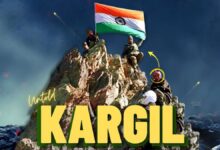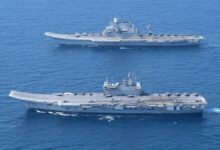Explained: Indian Navy’s Requirement Of Landing Platform Dock

Hello defence lovers! The Indian Navy has recently released its RFI to procure Landing Platform Dock. The procurement of these LPDs has been canceled earlier when a Rs 20,000 crore deal was scrapped. Now the Navy has relaunched the RFI with updated requirements. In this article, we are going to understand what Landing Platform Docks are, how these are used and the Indian Navy’s requirement of LPDs.
What is Landing Platfrom Dock?

San Antonio class LPD
A landing platform dock (LPD) is an amphibious warfare vessel specially designed for offensive beach landings. It is also known as Amphibious Transport Dock. The name is self-explanatory. These ships are generally large ( 10,000- 20,000 tons) and carry hundreds of soldiers, tanks, trucks, and helicopters depending upon the mission profile and requirements. These are generally used to transport troops into the warzone by sea using, primarily using landing crafts.
The Indian navy only operates one Austin Class LPD INS Jalaswaha, a former US Navy ship. Although it comes with many terms and conditions. The most important one is that it cannot be used in any offensive action unless authorized by the United States. This condition renders the ship quite useless as its primary role is to conduct offensive expeditionary landings. Though it has been extensively used in many humanitarian missions.
Other Navies around the world also operate Landing platform docks in significant numbers. The US navy is the largest operator of LPDs. It has 11 San Antonio class LPDs. US Navy is followed by the Indonesian Navy which operates 9 LPD in total. Chinese Navy also operates 7 LHD.
Indian Navy’s Requirement For Landing Platfrom Dock

INS Jalashwa
Vessels like Aircraft carriers and Landing platform docks are offensive platforms. With the changing world, the Indian navy must transform itself from a defensive maritime force to an expeditionary offensive force. For this transformation a significant number of assets like aircraft carriers and LPDs are mandatory. For a very long time, the procurement of LPDs is being postponed primarily due to a lack of funds. In 2003 the navy tried to procure LPDs and issued the RFP in 2011 which was ultimately scrapped in 2020. Compared to other bigger projects like Aircraft carriers and nuclear submarines, LPDs will be cheaper to construct and operate. As of now, the Indian navy has released an RFI for 4 LPDs which should be able to perform the following tasks:
- To Influence the Land Battle through a viable capability to transport and land ashore a combined arms force and to sustain their operations ashore.
- To Undertake Out of Area Contingencies (OOAC) through its inherent capability to transport and deploy forces ashore, ability to arrive quickly in area, and sustain operations at sea for prolonged durations.
- To Act as Command Centre for the Commander, Amphibious Task Force, Landing Force Commander and the Air Force Commander.
- To undertake Humanitarian Assistance and Disaster Relief Missions
- To act as mother ship for unmanned capability and to support operation/ exploitation of all dimensions of futuristic unmanned vehicles/ platforms/ equipment.
- To undertake fleet support functions through underway replenishment capability and comprehensive workshop facilities.
- To provide medical facilities for treatment of battle casualties.
Indian Navy’s RFI In A Nutshell:
- The lenght of each ship must be less or equal to 200 meters
- Ship’s crew will consist of 60 officers and 490 sailors, 20% of which will be women.
- The ship should have a range of 10,000 nautical miles with 45 days of minimum endurance.
- 16 ship launched surface to surface missiles
- 32 VLSRSAM ( Barak 8 missiles)
- 4 AK 630 with Electro Optical Fire Control System.
- 06 heavy machine guns with stabilised gun control stations.
- Capability to accomodate Directed Energy Weapons when developed.
- Should be able to caryy 900 troops with equipment.
- Should be able to accomodate 2 Heavy Lift Helicopters, 12 special operations helicopters and 2 unmanned aircrafts.
- Should be able to carry 6 Main battle tanks and 20 armoured vehicles.
- The ship should be able to launch Charriots* for special operation missions.
- The Ship should also be able to deploy unmanned water vehicles.
- The ship should have a through deck design.
*Chariots are special-purpose mini-submarines used by frogmen for covert operations. These are often extremely small and carry 2 to 4 frogmen only.
Click here to read the original RFI issued by the Indian Navy.
Conclusion

French Landing Helicopter dock with a through deck design.
It is interesting to note that the Indian Navy has asked for a thorough deck design. A through deck design is similar to that of an aircraft carrier or helicopter carrier. Thus what the Indian navy has asked for is a hybrid of a Landing helicopter dock and a Helicopter carrier. Also looking at the requirements the ships can very well serve as Helicopter carriers/ Landing helicopter docks if required. The displacement adhering to the requirements should be around 30,000 tons. As per the RFI, the delivery should start within 60 months of signing the contract. If we look at the timeline, assuming the ideal situation where the deal is signed within the next 5 years, the Indian navy is not going to get the delivery of the first Landing platform dock before 2030. As India’s economic power will grow, it will need to boost its naval power to counter its adversaries in the region and in the world. As without a strong expeditionary navy, India cannot become a true superpower. The British Empire expanded its reign throughout the world only because of its strong Navy. The United States is the world’s superpower only because of its strong navy. The Chinese have realized it much earlier. Thus the Indian government must realize this and invest in building a strong navy.




